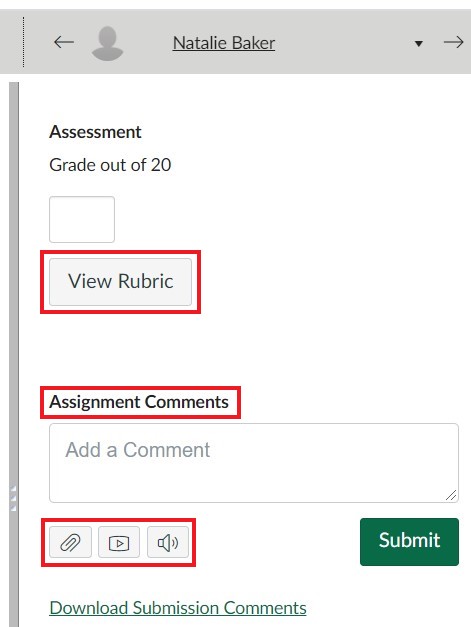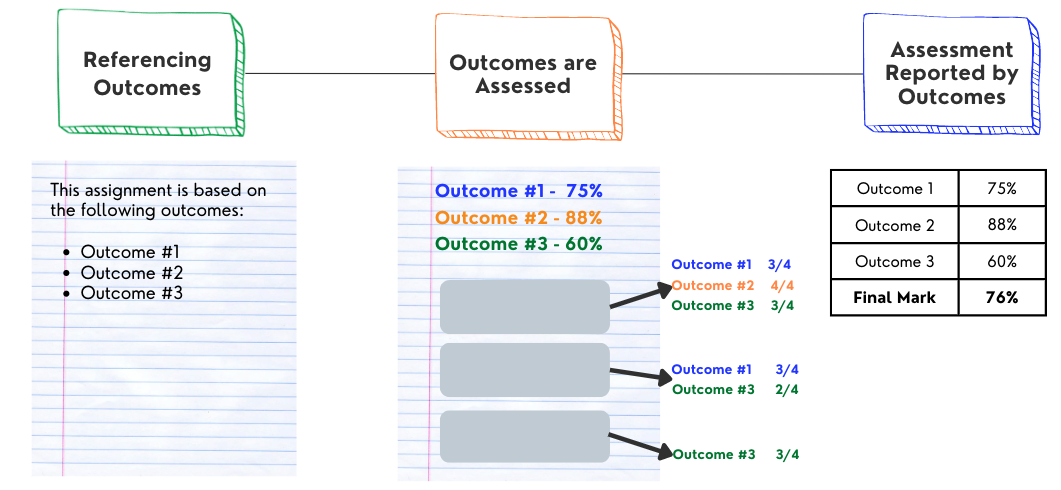How Canvas Supports Learner-Centred Assessment
By Roberta Campbell-Chudoba

This post is part of a series about using Canvas to integrate the eight Learning Technology Ecosystem Principles. In this post, we look at the Inclusive of learning-centred assessment principle.
- Inclusive of learning-centred assessment: Learning and feedback are iterative, and assessment comes from multiple sources, including self, peers, teachers, and outside experts.
Effective assessment practices follow from a learner-centred teaching approach, with practices designed to produce evidence of the kind of learning you want to measure, aligned with the learning outcomes for the course. Feedback needs to be both affirming and corrective in order for any of us to learn, and if it is unambiguous, specific, frequent, and timely, it motivates students to develop as thinkers and communicators. Information we gather from assessments results can be used to make continual improvements or changes in the classroom – therefore providing benefit to both students and instructors (Ambrose et al., 2010; Jensen & McConchie, 2020).
Canvas tools for providing feedback
The DocViewer tool allows you to make annotations directly onto assignments submitted online, in a variety of file types, inside Speedgrader. You can see when students have viewed your annotations or resubmitted assignments in the assignment details area of the Speedgrader sidebar. Students can comment directly within their own annotated document to reply to your feedback, or give feedback to peers if doing a peer review on an assignment submission.

Speedgrader gives you options for making comments in its sidebar: written text, audio  or video comments recorded right inside the tool, or speech to text when using Chrome as your browser. The sidebar comment area can be used for comments to online submissions of assignments, discussions, and quizzes. Students can reply to your comments with questions, responses and requests, accessed through their Grades page, allowing for instructor/student interaction within the Speedgrader tool.
or video comments recorded right inside the tool, or speech to text when using Chrome as your browser. The sidebar comment area can be used for comments to online submissions of assignments, discussions, and quizzes. Students can reply to your comments with questions, responses and requests, accessed through their Grades page, allowing for instructor/student interaction within the Speedgrader tool.
You can also make comments within an attached rubric, and attach a file to the comment area. Students doing peer reviews on discussion posts, can give their feedback within the comment sidebar of Speedgrader (not within the discussion area itself).
In New Quizzes, an option is available to add customized feedback to assessment questions, and can include media, links and/or images. In Classic Quizzes, you can enter automatic responses to answers when setting up a quiz, to provide immediate feedback to correct and incorrect answers.
Garnering feedback from outside experts is a challenge, whether delivering instruction remotely or face-to-face. One option is to support students to blog for credit within your course, giving them the opportunity to connect with an authentic audience beyond the classroom, and providing them motivation to ‘up-their-game’ with public-facing writing.
Finally, students can access the SLEQ evaluations for each course (at midterm and end of term, or end of term only, depending on instructor preference) from the Course Navigation menu. Ensure the link to the SLEQ is visible by making it ‘active’ in the Menu in each of your Canvas courses. Receiving feedback from students is part of the feedback loop that helps us as instructors to recognize and meet the needs of students, and can help us to improve our teaching practices.
References and Readings
Ambrose, S. A., Bridges, M. W., DiPietro, M., Lovett, M. C., & Norman, M. K. (2010). How learning works: 7 research-based principles for smart teaching. San Francisco, CA: Jossey-Bass.
Duncan, T., & Allison A Buskirk-Cohen, A. A. (2011). “Exploring learner-centered assessment: A cross-disciplinary approach.” International Journal on Teaching and Learning in Higher Education 23(2), 246-259. https://files.eric.ed.gov/fulltext/EJ946150.pdf
Jensen, E., & McConchie, L. (2020). Brain-based teaching: Teaching the way students really learn. 3rd Edition. Thousand Oaks, CA: Corwin Press.
Rich, J., Colon, A., Mines, D. and Jivers, K. (2014). Creating learner-centered assessment strategies for promoting greater student retention and class participation. Frontiers in Psychology, 5.3.
Photo by Lum3n on Pexels.
This resource is shared by the Gwenna Moss Centre for Teaching and Learning (GMCTL), University of Saskatchewan, under a CC BY-NC-SA license.


